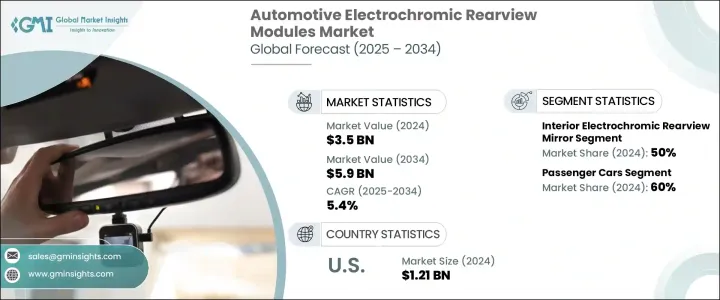
|
시장보고서
상품코드
1766223
자동차용 일렉트로크로믹 백미러 모듈 시장 기회, 성장 촉진요인, 산업 동향 분석, 예측(2025-2034년)Automotive Electrochromic Rearview Modules Market Opportunity, Growth Drivers, Industry Trend Analysis, and Forecast 2025 - 2034 |
||||||
세계의 자동차용 일렉트로크로믹 백미러 모듈 시장 규모는 2024년 35억 달러로 평가되었고, CAGR 5.4%를 나타내며 2034년에는 59억 달러에 이를 것으로 예측됩니다.
이 성장은 자동차 산업이 안전 중시의 드라이버 중심 기술로 변화하고 있는 것이 큰 요인이 되고 있습니다. 한때는 호화로운 기능이라고 생각되고 있던 일렉트로크로믹 미러는 현재는 보다 저렴한 차량 클래스에서 표준적인 안전 요소로서 정착하고 있어, 현대의 모빌리티에 있어서의 일렉트로크로믹 미러의 역할을 강화하고 있습니다.

단순한 조광 기능뿐만 아니라, 이러한 모듈은 지능형 운전 기술과 통합된 다기능 시스템으로 진화하고 있습니다. 보다 끊김 없이 커넥티드한 운전 체험이 가능해 집니다.의 기술을 통합하는 경향을 강화하고 있습니다. 제조 비용이 저하되고 그 이점이 보다 분명해짐에 따라, 인텔리전트백미러 모듈 수요는 보다 폭넓은 차종으로 급증할 것으로 예측됩니다.
| 시장 범위 | |
|---|---|
| 시작 연도 | 2024년 |
| 예측 연도 | 2025-2034년 |
| 시작 금액 | 35억 달러 |
| 예측 금액 | 59억 달러 |
| CAGR | 5.4% |
제품 세분화의 관점에서 시장은 실내용 전기 변색 후면 뷰 미러, 실외용(사이드) 전기 변색 미러, 디스플레이 및 센서를 갖춘 일체형 후면 보기 모듈을 포함합니다. 이 중 실내용 일렉트로크로믹 백미러 분야는 2024년에 세계 시장의 약 50%를 차지해 최대의 점유율을 기록했습니다. 또한 이 부문은 예측 기간 동안 CAGR 6.2% 이상을 나타낼 것으로 예측됩니다. 운전자의 편안함과 뒤에서 눈부심을 제거하는 것이 중요해지면서 자동차 제조업체는 주변 조명에 자동으로 적응할 수있는 룸 미러를 선호합니다. 디지털 시스템과의 통합으로, 특히 중급차와 고급차의 중간에 위치하는 차종에서의 채용이 진행되고 있습니다.
자동차용 일렉트로크로믹 백미러 모듈 시장을 차종별로 분류하면 승용차, 상용차, 전기차로 나뉩니다. 승용차는 2024년에 시장 전체의 60% 가까운 점유율을 획득하여 지배적인 부문으로 부상했습니다. 이 이점은 자가용 차량에서의 편안함과 안전성 강화의 인기가 높아짐에 따라 뒷받침됩니다. 기술 혁신이 고급차에서 대중차로 점차 침투함에 따라 눈부심을 줄이는 기능을 갖춘 백미러 미러가 표준 장비가 되고 있습니다. 이러한 거울은 특히 야간과 시가지의 교통 환경에서 운전자의 피로를 줄이고 도로의 시인성을 향상시키는 데 기여한다는 인지도가 높아지고 있습니다.
기술별로 볼 때 시장은 겔 기반, 고체 기반, 나노 재료 기반의 일렉트로 크로 믹 미러로 구분됩니다. 겔 기반 부문은 2024년 시장을 선도했으며, 신뢰성, 성능 및 비용 효율성의 균형이 좋기 때문에 계속해서 강한 지위를 차지하고 있습니다. 이러한 거울은 안정적인 착색 전이를 제공하고 생산이 용이하기 때문에 안전성과 기능성을 손상시키지 않고 저렴한 가격을 선호하는 중급차에 매우 적합합니다. 그 높은 적응성과 실적으로부터, 저비용으로 차량 성능의 향상을 목표로 하는 자동차 제조업체에 지지되고 있습니다.
시장은 또한 판매 채널에 따라 OEM과 애프터마켓으로 구분됩니다. 2024년에는 고급 미러 시스템을 자동차 제조에 직접 통합하여 OEM 부문이 명확한 리더가 되었습니다. OEM 제조업체는 보다 우수한 제품 정렬, 성능 및 신뢰성을 제공하며, 이는 후면 뷰 미러와 같은 안전성이 중요한 부품이 참여하는 경우 필수적입니다. 자동차 제조업체는 차량의 디지털 시스템과의 원활한 통합을 보장하기 위해 점점 더 OEM에 의존하고 있으며 OEM이 선호 채널로 강화되고 있습니다.
지역별로는 미국이 2024년 세계의 자동차용 일렉트로크로믹 백미러 모듈 시장을 선도하여 약 12억 1,000만 달러를 창출해 세계 시장 점유율의 약 84%를 차지했습니다. 이 이점은 자동차 기술 혁신의 고용률과 기능이 풍부한 자동차 시장의 호조에 힘입어지고 있습니다. 차 내 기능 강화에 대한 소비자의 관심 증가와 교통 안전에 대한 규제의 중시가 계속해서 국가 전체의 견조한 수요를 지지하고 있습니다.
업계 각사는 보다 고속으로 반응하는 조광 기술, 디스플레이 강화 미러, ADAS 플랫폼과의 통합 강화 등의 분야에서 기술 혁신에 대한 대처를 강화하고 있습니다. 자동차 조립 부문에 근접함으로써 제조업체는 변화하는 시장 수요에 신속하게 대응하고 제품 개발 사이클을 단축할 수 있습니다.
목차
제1장 조사 방법
- 시장의 범위와 정의
- 조사 디자인
- 조사 접근
- 데이터 수집 방법
- 데이터 마이닝 소스
- 세계
- 지역/국가
- 기본 추정과 계산
- 기준연도 계산
- 시장 예측의 주요 동향
- 1차 조사와 검증
- 1차 정보
- 예측 모델
- 조사의 전제와 한계
제2장 주요 요약
제3장 업계 인사이트
- 생태계 분석
- 공급자의 상황
- 이익률
- 비용 구조
- 각 단계에서의 부가가치
- 밸류체인에 영향을 주는 요인
- 파괴적 혁신
- 업계에 미치는 영향요인
- 성장 촉진요인
- 안전성과 촉진요인의 쾌적성에 대한 수요 증가
- ADAS(첨단 운전자 보조 시스템)의 도입 증가
- 고급차 및 하이엔드차의 판매 증가
- 기술의 진보와 스마트 시스템과의 통합
- 업계의 잠재적 위험 및 과제
- 일렉트로크로믹 기술의 고비용
- 차량 전자기기와의 복잡한 통합
- 시장 기회
- ADAS(첨단 운전자 보조 시스템)의 도입 확대
- 신흥 시장에서의 고급차 및 프리미엄차의 판매 증가
- 성장 촉진요인
- 성장 가능성 분석
- 규제 상황
- Porter's Five Forces 분석
- PESTEL 분석
- 기술과 혁신의 상황
- 현재의 기술 동향
- 신흥기술
- 특허 분석
- 가격 동향
- 지역
- 성분
- 생산 통계
- 생산 거점
- 소비 거점
- 수출과 수입
- 코스트 내역 분석
- 지속가능성과 환경 측면
- 지속가능한 관행
- 폐기물 삭감 전략
- 생산에 있어서의 에너지 효율
- 환경 친화적인 노력
- 탄소 발자국의 고려
제4장 경쟁 구도
- 서론
- 기업의 시장 점유율 분석
- 북미
- 유럽
- 아시아태평양
- 라틴아메리카
- 중동 및 아프리카
- 주요 시장 기업의 경쟁 분석
- 경쟁 포지셔닝 매트릭스
- 전략적 전망 매트릭스
- 주요 발전
- 합병과 인수
- 파트너십 및 협업
- 신제품 발매
- 확장계획과 자금조달
제5장 시장 추계·예측 : 제품별(2021-2034년)
- 주요 동향
- 실내 일렉트로크로믹 백미러
- 외부(측면) 일렉트로크로믹 백미러
- 센서/디스플레이를 갖춘 통합형 백미러 모듈
제6장 시장 추계·예측 : 차량별(2021-2034년)
- 주요 동향
- 승용차
- 해치백
- 세단
- SUV
- 상용차
- 소형 상용차(LCV)
- 중형 상용차(MCV)
- 대형 상용차(HCV)
- 전기자동차(EV)
제7장 시장 추계·예측 : 기술별(2021-2034년)
- 주요 동향
- 겔 기반
- 고체 상태
- 나노 재료 기반
제8장 시장 추계·예측 : 판매 채널별(2021-2034년)
- 주요 동향
- OEM
- 애프터마켓
제9장 시장 추계·예측 : 지역별(2021-2034년)
- 주요 동향
- 북미
- 미국
- 캐나다
- 유럽
- 영국
- 독일
- 프랑스
- 이탈리아
- 스페인
- 러시아
- 북유럽 국가
- 아시아태평양
- 중국
- 인도
- 일본
- 한국
- 호주 및 뉴질랜드
- 동남아시아
- 라틴아메리카
- 브라질
- 멕시코
- 아르헨티나
- 중동 및 아프리카
- 아랍에미리트(UAE)
- 사우디아라비아
제10장 기업 프로파일
- Burco
- CIPA
- Ficosa
- FLABEG
- Gentex
- Honda Lock
- Ichikoh
- Konview
- Magna
- Mitsuba
- Murakami
- Samvardhana Motherson
- Shenzhen Germid
- SL
- Tokai Rika
The Global Automotive Electrochromic Rearview Modules Market was valued at USD 3.5 billion in 2024 and is estimated to grow at a CAGR of 5.4% to reach USD 5.9 billion by 2034. This growth is largely driven by the automotive industry's shift toward safety-focused and driver-centric technologies. Electrochromic rearview mirrors are becoming increasingly common across a broader range of vehicles due to their ability to automatically adjust to varying light conditions. This functionality significantly improves nighttime visibility while reducing eye strain, factors that continue to influence buyer preferences. What was once considered a luxury feature is now gaining ground as a standard safety element across more affordable vehicle classes, reinforcing the role of electrochromic mirrors in modern mobility.

Beyond just dimming capabilities, these modules are evolving into multifunctional systems integrated with intelligent driving technologies. Modern rearview mirrors are no longer passive glass units-they now operate as part of a vehicle's digital ecosystem. Many feature embedded displays, smart sensors, rearview cameras, and support for advanced driver-assistance systems. These integrations enable a more seamless and connected driving experience. Automakers are increasingly embedding this technology into both premium and mid-range models to enhance the in-cabin experience and differentiate themselves in an intensely competitive market. As the cost of manufacturing decreases and the benefits become more evident, the demand for intelligent rearview modules is expected to surge across a wider range of vehicle types.
| Market Scope | |
|---|---|
| Start Year | 2024 |
| Forecast Year | 2025-2034 |
| Start Value | $3.5 Billion |
| Forecast Value | $5.9 Billion |
| CAGR | 5.4% |
In terms of product segmentation, the market includes interior electrochromic rearview mirrors, exterior (side) electrochromic mirrors, and integrated rearview modules featuring displays and sensors. Among these, the interior electrochromic rearview mirror segment held the largest share in 2024, accounting for approximately 50% of the global market. This segment is also anticipated to grow at a CAGR of over 6.2% during the forecast period. The growing emphasis on driver comfort and the elimination of rear glare has pushed automakers to prioritize interior mirrors that can automatically adapt to ambient lighting. Their integration with digital systems has further boosted adoption, particularly in vehicles positioned between mid-range and high-end categories.
When categorized by vehicle type, the automotive electrochromic rearview modules market is divided into passenger cars, commercial vehicles, and electric vehicles. Passenger cars emerged as the dominant segment in 2024, capturing nearly 60% of the total market share. This dominance is underpinned by the rising popularity of comfort and safety enhancements in private vehicles. As technological innovations continue to trickle down from luxury cars to mass-market models, rearview mirrors with glare-reducing capabilities are becoming standard features. These mirrors are increasingly recognized for their contribution to reducing driver fatigue and improving road visibility, especially during nighttime and in urban traffic environments.
By technology, the market is segmented into gel-based, solid-state, and nanomaterial-based electrochromic mirrors. The gel-based segment led the market in 2024 and continues to hold a strong position due to its balance of reliability, performance, and cost-efficiency. These mirrors offer consistent tinting transitions and are easier to produce, making them highly suitable for mid-range vehicles that prioritize affordability without compromising safety and functionality. Their strong adaptability and proven track record make them a favored choice among automakers aiming to enhance vehicle performance at a lower cost.
The market is also segmented based on sales channels into OEM and aftermarket. In 2024, the OEM segment was the clear leader, driven by the increased integration of advanced mirror systems directly into vehicle manufacturing. Original equipment manufacturers offer better product alignment, performance, and reliability, which are essential when safety-critical components like rearview mirrors are involved. Automakers increasingly rely on OEMs to ensure seamless integration with a vehicle's digital systems, reinforcing OEMs as the preferred channel.
Regionally, the United States led the global automotive electrochromic rearview modules market in 2024, generating around USD 1.21 billion and accounting for approximately 84% of the global market share. This dominance is fueled by high adoption rates of automotive innovations and a strong market for feature-rich vehicles. The growing consumer interest in in-cabin enhancements and regulatory emphasis on road safety continues to support robust demand across the country.
Industry players are ramping up efforts to innovate in areas like faster-reacting dimming technology, display-enhanced mirrors, and enhanced integration with ADAS platforms. Strategic manufacturing and R&D expansion in major automotive regions, including North America, Europe, and Asia, is becoming increasingly important for staying competitive. Proximity to vehicle assembly units allows manufacturers to quickly adapt to shifting market demands and shorten product development cycles. As this sector matures, suppliers and automakers alike are prioritizing tighter collaboration to meet evolving performance expectations, design trends, and safety standards.
Table of Contents
Chapter 1 Methodology
- 1.1 Market scope and definition
- 1.2 Research design
- 1.2.1 Research approach
- 1.2.2 Data collection methods
- 1.3 Data mining sources
- 1.3.1 Global
- 1.3.2 Regional/Country
- 1.4 Base estimates and calculations
- 1.4.1 Base year calculation
- 1.4.2 Key trends for market estimation
- 1.5 Primary research and validation
- 1.5.1 Primary sources
- 1.6 Forecast model
- 1.7 Research assumptions and limitations
Chapter 2 Executive Summary
- 2.1 Industry 3600 synopsis
- 2.2 Key market trends
- 2.2.1 Regional
- 2.2.2 Product
- 2.2.3 Vehicle
- 2.2.4 Technology
- 2.2.5 End use
- 2.3 TAM Analysis, 2025-2034
- 2.4 CXO perspectives: Strategic imperatives
- 2.4.1 Key decision points for industry executives
- 2.4.2 Critical success factors for market players
- 2.5 Future outlook and strategic recommendations
Chapter 3 Industry Insights
- 3.1 Industry ecosystem analysis
- 3.1.1 Supplier landscape
- 3.1.2 Profit margin
- 3.1.3 Cost structure
- 3.1.4 Value addition at each stage
- 3.1.5 Factor affecting the value chain
- 3.1.6 Disruptions
- 3.2 Industry impact forces
- 3.2.1 Growth drivers
- 3.2.1.1 Increasing demand for safety and driver comfort
- 3.2.1.2 Rising adoption of advanced driver assistance systems (ADAS)
- 3.2.1.3 Growth in luxury and high-end vehicle sales
- 3.2.1.4 Technological advancements and integration with smart systems
- 3.2.2 Industry pitfalls & challenges
- 3.2.2.1 High cost of electrochromic technology
- 3.2.2.2 Complex integration with vehicle electronics
- 3.2.3 Market opportunities
- 3.2.3.1 Growing adoption of advanced driver assistance systems (ADAS)
- 3.2.3.2 Rising luxury and premium vehicle sales in emerging markets
- 3.2.1 Growth drivers
- 3.3 Growth potential analysis
- 3.4 Regulatory landscape
- 3.5 Porter's analysis
- 3.6 PESTEL analysis
- 3.7 Technology and innovation landscape
- 3.7.1 Current technological trends
- 3.7.2 Emerging technologies
- 3.8 Patent analysis
- 3.9 Price trends
- 3.9.1 Region
- 3.9.2 Component
- 3.10 Production statistics
- 3.10.1 Production hubs
- 3.10.2 Consumption hubs
- 3.10.3 Export and import
- 3.11 Cost breakdown analysis
- 3.12 Sustainability and environmental aspects
- 3.12.1 Sustainable practices
- 3.12.2 Waste reduction strategies
- 3.12.3 Energy efficiency in production
- 3.12.4 Eco-friendly initiatives
- 3.12.5 Carbon footprint considerations
Chapter 4 Competitive Landscape, 2024
- 4.1 Introduction
- 4.2 Company market share analysis
- 4.2.1 North America
- 4.2.2 Europe
- 4.2.3 Asia Pacific
- 4.2.4 Latin America
- 4.2.5 Middle East & Africa
- 4.3 Competitive analysis of major market players
- 4.4 Competitive positioning matrix
- 4.5 Strategic outlook matrix
- 4.6 Key developments
- 4.6.1 Mergers & acquisitions
- 4.6.2 Partnerships & collaborations
- 4.6.3 New Product Launches
- 4.6.4 Expansion Plans and funding
Chapter 5 Market Estimates & Forecast, By Product, 2021 - 2034 ($Mn, Units)
- 5.1 Key trends
- 5.2 Interior electrochromic rearview mirror
- 5.3 Exterior (side) electrochromic rearview mirror
- 5.4 Integrated rearview modules with sensors/displays
Chapter 6 Market Estimates & Forecast, By Vehicle, 2021 - 2034 ($Mn, Units)
- 6.1 Key trends
- 6.2 Passenger cars
- 6.2.1 Hatchback
- 6.2.2 Sedan
- 6.2.3 SUV
- 6.3 Commercial vehicles
- 6.3.1 Light commercial vehicles (LCV)
- 6.3.2 Medium commercial vehicles (MCV)
- 6.3.3 Heavy commercial vehicles (HCV)
- 6.4 Electric vehicles (EV)
Chapter 7 Market Estimates & Forecast, By Technology, 2021 - 2034 ($Mn, Units)
- 7.1 Key trends
- 7.2 Gel-based
- 7.3 Solid-state
- 7.4 Nanomaterial-based
Chapter 8 Market Estimates & Forecast, By Sales Channel, 2021 - 2034 ($Mn, Units)
- 8.1 Key trends
- 8.2 OEM
- 8.3 Aftermarket
Chapter 9 Market Estimates & Forecast, By Region, 2021 - 2034 ($Mn, Units)
- 9.1 Key trends
- 9.2 North America
- 9.2.1 U.S.
- 9.2.2 Canada
- 9.3 Europe
- 9.3.1 UK
- 9.3.2 Germany
- 9.3.3 France
- 9.3.4 Italy
- 9.3.5 Spain
- 9.3.6 Russia
- 9.3.7 Nordics
- 9.4 Asia Pacific
- 9.4.1 China
- 9.4.2 India
- 9.4.3 Japan
- 9.4.4 South Korea
- 9.4.5 ANZ
- 9.4.6 Southeast Asia
- 9.5 Latin America
- 9.5.1 Brazil
- 9.5.2 Mexico
- 9.5.3 Argentina
- 9.6 MEA
- 9.6.1 UAE
- 9.6.2 Saudi Arabia
Chapter 10 Company Profiles
- 10.1 Burco
- 10.2 CIPA
- 10.3 Ficosa
- 10.4 FLABEG
- 10.5 Gentex
- 10.6 Honda Lock
- 10.7 Ichikoh
- 10.8 Konview
- 10.9 Magna
- 10.10 Mitsuba
- 10.11 Murakami
- 10.12 Samvardhana Motherson
- 10.13 Shenzhen Germid
- 10.14 SL
- 10.15 Tokai Rika



















